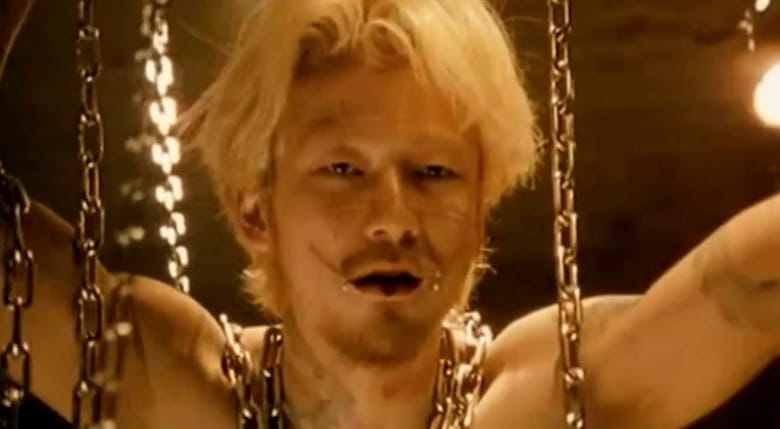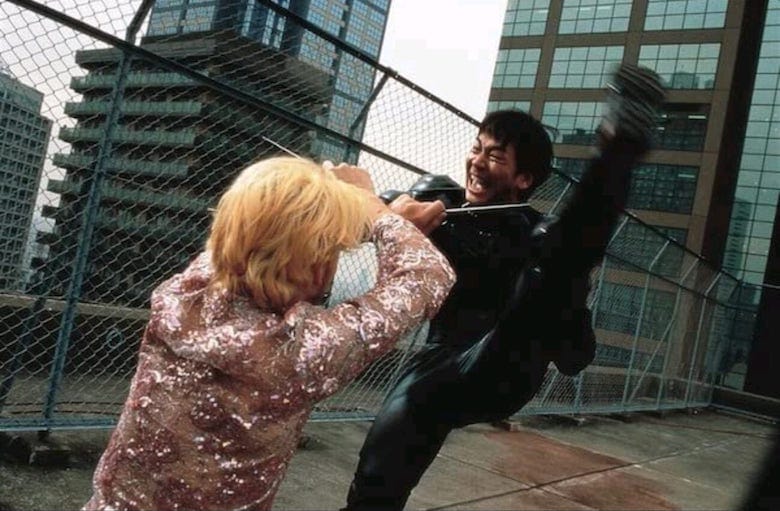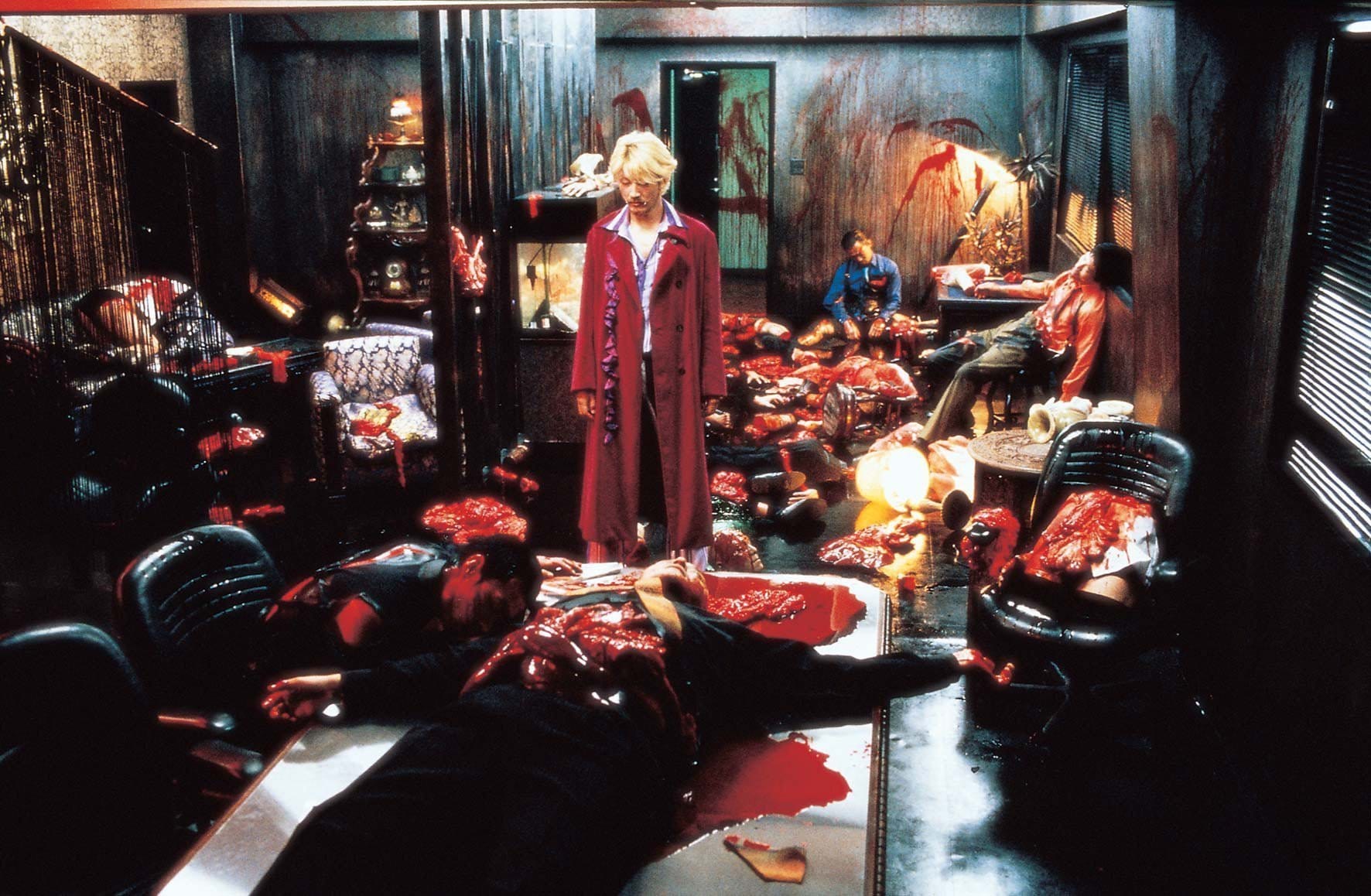Takashi Miike, the celebrated Japanese director with many cult classics under his belt, broke new ground in 2001 with his violent, shocking, and beautiful Yakuza tale Ichi the Killer. If Audition brought Miike mass attention, Ichi the Killer is surely his opus, dividing and polarizing people around the world, drawing praise and condemnation alike, and showcasing all the brilliance Miike has to offer.
The twisted, depraved portrayal of the Yakuza is based on a manga created by Hideo Yamamoto, bringing to the screen a faithful representation of the original, while making subtle changes that make the film its own entity.

Specifically, the Ichi the Killer ending goes an entirely different direction, creating a far more ironic, circumspect conclusion. Throughout the film, Miike’s use of graphic violence as an aesthetic device is what sets Ichi the Killer apart and makes it a cult classic.
Miike’s Beautiful Violence
Ichi the Killer juxtaposes two main characters – Kakihara, a masochist right-hand-man in the Yakuza who finds meaning in being beaten and tortured. When his boss suddenly disappears, it leaves a vacuum in his life regarding his overwhelming masochism while also elevating him to a position of power which he must reconcile. On the other side is Ichi, a shy, introvert psychopath who is the perfect killing machine, employed by the crafty and sinister Jijii to cripple the Yakuza from within for his own personal vendetta.
Jijii stays in the background and sets Ichi on key Yakuza personnel. Kakihara’s boss is Ichi’s first victim, and the killing is one of the most brutal and gory sequences you will ever see on screen. The room where the boss is killed resembled a twisted Jackson Pollock painting after Ichi is through with him. However, specialist cleaners are sent to the scene to completely remove any trace of the murder and the body. The juxtaposition of the horrific murder room image with another where the room is completely clean and sanitized further drives home the impact of the violence.
The film also contains some of the most brutal torture ever captured on camera. On his quest to find his boss, Kakihara questions key witnesses he expects would have information about his disappearance, torturing and mutilating them in unique and visually stunning ways but to no avail. The highly stylized torture scenes, shot from multiple uncomfortable angles and featuring a lot of blood, represent the inner hunger of the masochist Kakihara to be punished himself. Through torturing others, he tries to fulfil his need to be tortured himself, a role that would previously be played by his boss.
With Ichi, things are more complicated. The violence is not always willing or enjoyable. Sometimes, it is purely a matter of programming and habit. Other times, he displays a strange conflict, getting fleeting feelings of guilt and remorse but switching gears and displaying violence anyway. At his heart, Ichi is a pervert and a psychopath and most of his moments of pause and soul-searching lead nowhere good.
Ichi the Killer – Ending Analysis
The ending in Ichi the Killer veers away from the resolution offered in the original Manga. From the very beginning, the viewer’s expect a final showdown between Kakihara and Ichi.

However, unlike most people would imagine, this is not for revenge. Rather, Kakihara actively seeks out Ichi seeing the violence he is capable of in the hope that Ichi would be able to give him the pain and suffering he actively seeks since the disappearance of his boss. In a way, he wants Ichi to torture and mutilate him to fill that incredible void.
When the super-masochist does meet the super-sadist in the end, things do not go as planned. Kakihara quickly realizes that Ichi is not the monster he was looking for and that he would be incapable of delivering the punishment he desperately needs. Ichi, in fact, is reduced to sobbing and crying and becomes incapable of violence. Kakihara stabs his own ears to drown out the sound, imagines himself being tortured by Ichi, and throws himself off a building to his death. Ichi is then killed by Takeshi, a young boy who idolized Ichi but sees him for the monster that he is.
A Tour de Force of Violence
The ending is far more contemplative and less disturbing than the original manga, showing a dystopian future where a grown-up Takeshi is shown walking with schoolchildren and the corpse of Jijii, who hangs himself in the end. It is an ending where no one gets redemption or happiness, straight out of Miike’s playbook. The violence, while being bloody and gratuitous, serves the role of abstract painting on canvas as the story winds down. The characters, with their strange obsessions and affinity for bloodbath, remain etched in the memory of viewers.
Altogether, for lovers of horror, Ichi the Killer is a consummate classic that delivers with every watch and forces viewers to think and reflect on their own obsessions and quirks.
Last Updated on June 22, 2021.

